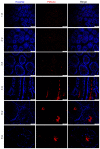PMCA4 gene expression is regulated by the androgen receptor in the mouse testis during spermatogenesis
- PMID: 33355366
- PMCID: PMC7789089
- DOI: 10.3892/mmr.2020.11791
PMCA4 gene expression is regulated by the androgen receptor in the mouse testis during spermatogenesis
Abstract
The present study aimed to investigate the expression of ATPase Ca++ transporting plasma membrane 4 (PMCA4) in mouse testis and to determine its role in spermatogenesis. Reverse transcription‑quantitative PCR, western blotting and immunofluorescence were performed to evaluate the expression levels of PMCA4 in mouse testes at various weeks postnatal in wild type mice, and in testes from Sertoli cell‑specific androgen receptor knockout and androgen receptor knockout (ARKO) mice. Luciferase assay, androgen receptor (AR) overexpression and AR antagonist experiments were used to confirm that AR regulated the expression of PMCA4. The results demonstrated that PMCA4 was highly expressed in mouse testes at 3‑8 weeks postnatal. PMCA4 expression levels in ARKO mouse testes were decreased compared with wild type. In addition, activation of AR by testosterone administration resulted in an increase in the activity of the PMCA4 promoter. Cells transfected with an AR‑overexpressing plasmid exhibited increased expression levels of the PMCA4 protein. Finally, the increase in PMCA4 protein levels induced by testosterone was prevented by pre‑treatment with the AR antagonist flutamide. The present results confirmed that PMCA4 was upregulated during mouse testis development and that PMCA4 mRNA and protein expression levels were regulated by androgens and AR. The present findings suggest that PMCA4 may be involved in the regulation of spermatogenesis.
Keywords: ATPase Ca++ transporting plasma membrane 4; spermatogenesis; testis; androgen receptor.
Figures







Similar articles
-
Transcriptional regulation of PEBP1 expression by androgen receptor in mouse testes.Syst Biol Reprod Med. 2022 Feb;68(1):70-79. doi: 10.1080/19396368.2021.2004471. Epub 2021 Dec 12. Syst Biol Reprod Med. 2022. PMID: 34894936
-
Alanine and arginine rich domain containing protein, Aard, is directly regulated by androgen receptor in mouse Sertoli cells.Mol Med Rep. 2017 Jan;15(1):352-358. doi: 10.3892/mmr.2016.6028. Epub 2016 Dec 12. Mol Med Rep. 2017. PMID: 27959439
-
Androgen receptor roles in spermatogenesis and fertility: lessons from testicular cell-specific androgen receptor knockout mice.Endocr Rev. 2009 Apr;30(2):119-32. doi: 10.1210/er.2008-0025. Epub 2009 Jan 27. Endocr Rev. 2009. PMID: 19176467 Free PMC article. Review.
-
[Expression characteristics of the USP24 gene in the mouse testis during spermatogenesis].Zhonghua Nan Ke Xue. 2017 Nov;23(11):963-968. Zhonghua Nan Ke Xue. 2017. PMID: 29738159 Chinese.
-
Androgen receptor roles in spermatogenesis and infertility.Best Pract Res Clin Endocrinol Metab. 2015 Aug;29(4):595-605. doi: 10.1016/j.beem.2015.04.006. Epub 2015 Apr 25. Best Pract Res Clin Endocrinol Metab. 2015. PMID: 26303086 Review.
Cited by
-
MiR-34b/c play a role in early sex differentiation of Amur sturgeon, Acipenser schrenckii.Front Zool. 2022 Sep 26;19(1):23. doi: 10.1186/s12983-022-00469-6. Front Zool. 2022. PMID: 36163040 Free PMC article.
-
Ganoderic acid A ameliorates non-alcoholic streatohepatitis (NASH) induced by high-fat high-cholesterol diet in mice.Exp Ther Med. 2022 Apr;23(4):308. doi: 10.3892/etm.2022.11237. Epub 2022 Feb 24. Exp Ther Med. 2022. PMID: 35340879 Free PMC article.
-
The Prognostic Relevance of PMCA4 Expression in Melanoma: Gender Specificity and Implications for Immune Checkpoint Inhibition.Int J Mol Sci. 2022 Mar 19;23(6):3324. doi: 10.3390/ijms23063324. Int J Mol Sci. 2022. PMID: 35328746 Free PMC article.
-
What Does Androgen Receptor Signaling Pathway in Sertoli Cells During Normal Spermatogenesis Tell Us?Front Endocrinol (Lausanne). 2022 Feb 24;13:838858. doi: 10.3389/fendo.2022.838858. eCollection 2022. Front Endocrinol (Lausanne). 2022. PMID: 35282467 Free PMC article. Review.
-
Unraveling the Multifaceted Roles of Extracellular Vesicles: Insights into Biology, Pharmacology, and Pharmaceutical Applications for Drug Delivery.Int J Mol Sci. 2023 Dec 29;25(1):485. doi: 10.3390/ijms25010485. Int J Mol Sci. 2023. PMID: 38203656 Free PMC article. Review.
References
-
- De Gendt K, Swinnen JV, Saunders PT, Schoonjans L, Dewerchin M, Devos A, Tan K, Atanassova N, Claessens F, Lécureuil C, et al. A Sertoli cell-selective knockout of the androgen receptor causes spermatogenic arrest in meiosis. Proc Natl Acad Sci USA. 2004;101:1327–1332. doi: 10.1073/pnas.0308114100. - DOI - PMC - PubMed
MeSH terms
Substances
LinkOut - more resources
Full Text Sources
Molecular Biology Databases
Research Materials

